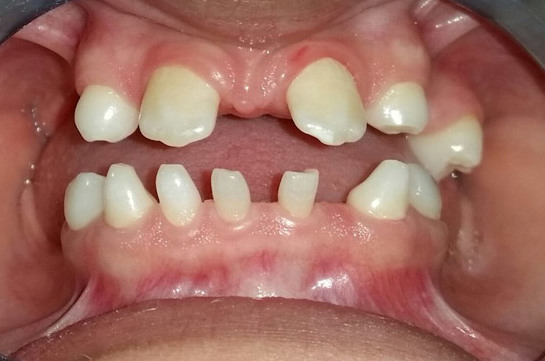Anodontia

Editor-In-Chief: Prab R Tumpati, MD
Obesity, Sleep & Internal medicine
Founder, WikiMD Wellnesspedia &
W8MD medical weight loss NYC and sleep center NYC
| Anodontia | |
|---|---|

| |
| Synonyms | Congenital absence of teeth |
| Pronounce | N/A |
| Specialty | N/A |
| Symptoms | Absence of all primary or permanent teeth |
| Complications | Malnutrition, speech disorder, facial deformity |
| Onset | Congenital |
| Duration | Lifelong |
| Types | N/A |
| Causes | Genetic mutations, often associated with ectodermal dysplasia |
| Risks | Genetic predisposition |
| Diagnosis | Clinical examination, radiographic imaging |
| Differential diagnosis | Hypodontia, oligodontia |
| Prevention | None |
| Treatment | Prosthetic dentistry, dental implants, orthodontics |
| Medication | N/A |
| Prognosis | Variable, depending on treatment |
| Frequency | Rare |
| Deaths | N/A |
Alternate Names[edit]
Anodontia of permanent dentition; Absence of permanent teeth
Definition[edit]
(an-o -don' -she-ah) [dv, priv.; coouc, tooth]. Absence of the teeth. Anodontia is a dental condition characterized by complete absence of teeth.

Classification[edit]
- True anodontia: It is of two types
- Total Anodontia: Total anodontia, in which all teeth are missing, may involve both deciduous and permanent dentition. This is a rare condition; when it occurs, it is frequently associated with a more generalized disturbance, hereditary ectodermal dysplasia.
- True partial anodontia (hypodontia or oligodontia): It involves missing of one or more teeth.
- Induced or false anodontia : It occurs as a result of extraction of all teeth.
- Pseudoanodontia : It refers to multiple unerupted teeth.
Summary[edit]
The primary (baby) or permanent (adult) teeth may be involved. Anodontia is extremely rare when present in a pure form (without associated abnormalities). In most cases, the phenomenon is associated with a group of conditions called the ectodermal dysplasias. In these cases, abnormalities are also noted in the hair, nails, and sweat glands.
Cause[edit]
A specific gene has not yet been identified.
Inheritance[edit]

Anodontia is an autosomal recessive condition.
Treatment[edit]
Prosthetic replacement of missing teeth is possible using dental implant technology or dentures. This treatment can be successful in giving patients with anodontia a more aesthetically pleasing appearance. The use of an implant prosthesis in the lower jaw could be recommended for younger patients as it is shown to significantly improve the craniofacial growth, social development and self-image.
| Developmental tooth disease/tooth abnormality | ||||||||||
|---|---|---|---|---|---|---|---|---|---|---|
|
NIH genetic and rare disease info[edit]
Anodontia is a rare disease.
| Rare and genetic diseases | ||||||
|---|---|---|---|---|---|---|
|
Rare diseases - Anodontia
|
Ad. Transform your life with W8MD's Budget GLP-1 injections from $75


W8MD offers a medical weight loss program to lose weight in Philadelphia. Our physician-supervised medical weight loss provides:
- Weight loss injections in NYC (generic and brand names):
- Zepbound / Mounjaro, Wegovy / Ozempic, Saxenda
- Most insurances accepted or discounted self-pay rates. We will obtain insurance prior authorizations if needed.
- Generic GLP1 weight loss injections from $75 for the starting dose.
- Also offer prescription weight loss medications including Phentermine, Qsymia, Diethylpropion, Contrave etc.
NYC weight loss doctor appointmentsNYC weight loss doctor appointments
Start your NYC weight loss journey today at our NYC medical weight loss and Philadelphia medical weight loss clinics.
- Call 718-946-5500 to lose weight in NYC or for medical weight loss in Philadelphia 215-676-2334.
- Tags:NYC medical weight loss, Philadelphia lose weight Zepbound NYC, Budget GLP1 weight loss injections, Wegovy Philadelphia, Wegovy NYC, Philadelphia medical weight loss, Brookly weight loss and Wegovy NYC
|
WikiMD's Wellness Encyclopedia |
| Let Food Be Thy Medicine Medicine Thy Food - Hippocrates |
Medical Disclaimer: WikiMD is not a substitute for professional medical advice. The information on WikiMD is provided as an information resource only, may be incorrect, outdated or misleading, and is not to be used or relied on for any diagnostic or treatment purposes. Please consult your health care provider before making any healthcare decisions or for guidance about a specific medical condition. WikiMD expressly disclaims responsibility, and shall have no liability, for any damages, loss, injury, or liability whatsoever suffered as a result of your reliance on the information contained in this site. By visiting this site you agree to the foregoing terms and conditions, which may from time to time be changed or supplemented by WikiMD. If you do not agree to the foregoing terms and conditions, you should not enter or use this site. See full disclaimer.
Credits:Most images are courtesy of Wikimedia commons, and templates, categories Wikipedia, licensed under CC BY SA or similar.
Translate this page: - East Asian
中文,
日本,
한국어,
South Asian
हिन्दी,
தமிழ்,
తెలుగు,
Urdu,
ಕನ್ನಡ,
Southeast Asian
Indonesian,
Vietnamese,
Thai,
မြန်မာဘာသာ,
বাংলা
European
español,
Deutsch,
français,
Greek,
português do Brasil,
polski,
română,
русский,
Nederlands,
norsk,
svenska,
suomi,
Italian
Middle Eastern & African
عربى,
Turkish,
Persian,
Hebrew,
Afrikaans,
isiZulu,
Kiswahili,
Other
Bulgarian,
Hungarian,
Czech,
Swedish,
മലയാളം,
मराठी,
ਪੰਜਾਬੀ,
ગુજરાતી,
Portuguese,
Ukrainian



